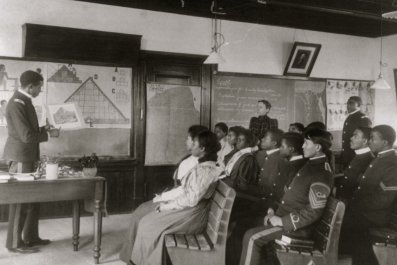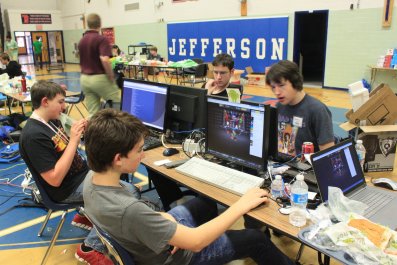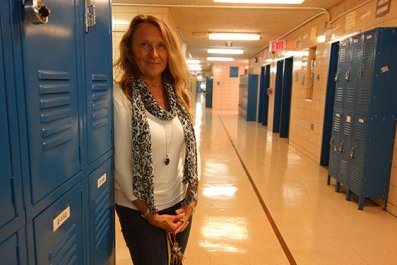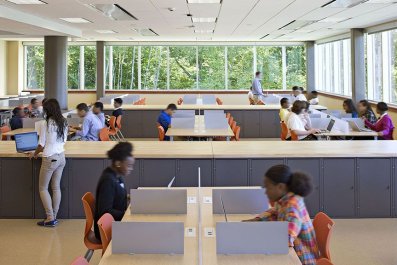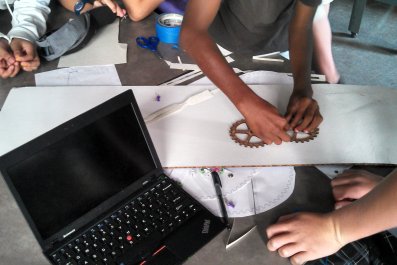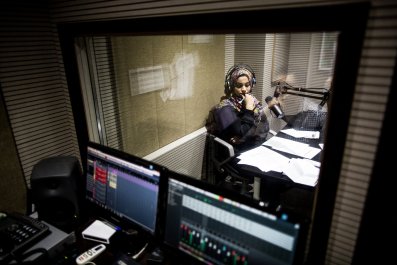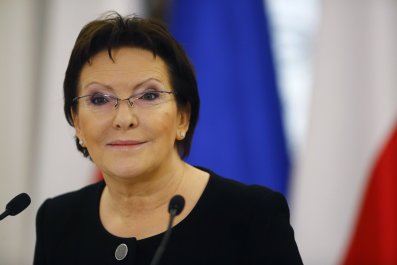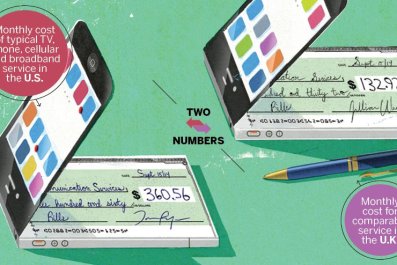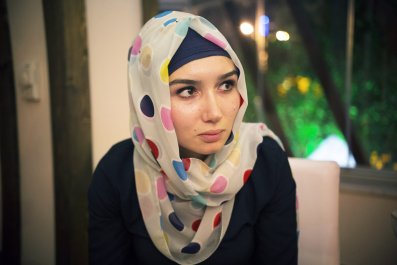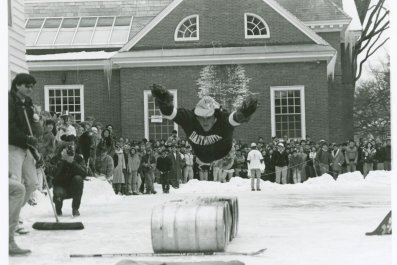When Maryam Mirzakhani became the first woman in history to win a Fields Medal last month, the mathematical equivalent of the Nobel Prize, her feat was hailed as a milestone in efforts to undermine the corrosive stereotype that maths is not for girls. But, just as inspiring as the real life triumph of Mirzakhani, are the dogged efforts of fictional Lisa Simpson, who has been a cartoon role model for rational thinking for more than a quarter of a century.
In an event at the Science Museum in London on 26th September, Simon Singh, author of The Simpsons and their Mathematical Secrets, will explain how the Fox animated sitcom is the most mathematically-sophisticated show in the history of prime time broadcasting, and that Lisa is a critical ingredient. "When I talk to school kids about the mathematics hidden in The Simpsons, I always stress Lisa's character, because she is such a great role model for girls who might be budding geeks or nascent nerds," he says.
Joining Singh in the museum will be two renowned Simpsons writers: David X Cohen, who has a degree in computer science at the University of California, Berkeley (and is also the creative force behind Futurama); and Al Jean, who worked on the first series and is now executive producer, and who went to Harvard University to study mathematics at the age of 16.
Among the many other Simpsons writers, Ken Keeler has a doctorate in applied mathematics and J. Stewart Burns a bachelor's degree in mathematics, both from Harvard University; Jeff Westbrook a PhD in computer science from Princeton who held a faculty position in Yale.
No wonder the The Simpsons show has been peppered with mathematical references since the first proper episode of the series in 1989 (which included a joke about calculus). These arcane flourishes include appearances by the French mathematician Blaise Pascal and the Cambridge theoretical physicist Stephen Hawking, various jokes about pi, and much more. In "The PTA Disbands", Lisa gets so bored by a lack of schooling she builds a perpetual motion machine, prompting Homer to declare: "Lisa, in this house we OBEY the laws of thermodynamics." "We love to infuse The Simpsons with as much subliminal knowledge as possible," says Jean. "Maths, art and even recipes for lentil soup, which we put into Paul McCartney's performance of 'Maybe I'm Amazed'."
Among the cast, Lisa stands out as a beacon of rational thinking. The perpetual eight-year-old took her Little League baseball team to the championship with the help of statistics, delivered a paper at the 12th Annual Big Science Thing ("Airborne Pheromones and Aggression in Bullies") and used maths to improve brother Bart's golf. When benches fall on her in one episode, Principal Skinner cries out: "She's been crushed . . . so have the hopes of our mathletics team!"
"Lisa is my favourite character to write for," explains Jean, paying tribute to her "incredible voice actress" Yeardley Smith. "I am so proud that she has become a symbol for those of like mind." Jean is well aware of Lisa's inspirational qualities. "I have two daughters, so as a father I could not be more of an advocate of girls entering and flourishing in the physical sciences."
Of all the episodes, Jean singles out "Girls Just Want to Have Sums", written by non-mathematician Matt Selman. The episode appeared in 2006, the year after Lawrence Summers, then president of Harvard University and the man who would be director of President Barack Obama's National Economic Council, speculated that the dearth of women in the upper levels of science is rooted in biology, whether due to a lack of drive or a fundamental difference in the wiring of their brains.
Summers triggered a firestorm of anger and concerns that his speculation would discourage young women from maths and science (which would contribute to his resignation the next year). "In Girls Just Want to Have Sums", Principal Skinner declares that "From what I've seen, boys are better at math, science – the real subjects." After a hate campaign, he is replaced by radical educationalist, Melanie Upfoot, who wants to indoctrinate Lisa with mathematics that is both feminist and feminine, where women debate how numbers make them feel and don't simply attack problems, as those masculine mathematicians do.
Lisa is unimpressed. Following in the footsteps of Sophie Germain – the great 18th-century French mathematician, who was forced to adopt a male pseudonym, Monsieur LeBlanc, to study mathematics – Lisa disguises herself and joins the lesson intended for boys. She proves that she is indeed the best mathematician in the class. But we never find out Lisa's take on the gender gap. Matt Selman told Singh that he and his fellow Simpsons writers "did not want to deliver a simplistic or glib conclusion" Neither did they want to get into "Skinner-like trouble". However, they did ensure that Lisa declared: "Whatever the reason is, I'm glad I'm a girl, and I'm glad I'm good at math!"
Yes, women have made gains in closing the scientific gender gap, but their under-representation remains striking. In Britain, for example, women represent only 9% of people in non-medical science, technology or maths careers, according to the Campaign for Science and Engineering, based in London. Throw a stone in a national academy of science and it is likely to hit a man.
Jason Sheltzer, a cancer biologist at the Massachusetts Institute of Technology (MIT) and Joan Smith, a software engineer at Twitter, reviewed data on more than 9,000 graduate students and postdoctoral fellows in 39 departments within 24 leading American research institutions and found that, in labs led by male professors, women account for an average of 36% of postdoctorates and 47% of graduate students. In labs run by female professors, 46% of postdoctorates and 53% of graduate students are women. The greatest gender gap was found in the laboratories of the 22 male Nobel prizewinners, where male postdoctorates outnumber women three to one.
Perhaps men are more likely to apply to a lab with a male principal – and vice versa for women – but, "if the top labs don't train women, given these are the feeder labs for top jobs, then women are in trouble", remarks Ben Barres.
He knows only too well how the male-dominated scientific establishment treats women. Ben was born Barbara and was discouraged from setting her sights on MIT. Once there, she was told that a hard mathematical problem that she had answered, and that had stumped most men in the class, must have been solved by her boyfriend. Since 1997 Barres has been "a female-to-male transgendered person" and is now a professor of neuroscience at Stanford. "Nothing's changed at all," he says. "Women are still very under-represented in stem fields, in leadership positions, as CEOs, in the VC world and biotech worlds and in big pharma leadership. It is really shocking."
Scientists have long asked whether there are "male" and "female" brains. It's known that female brains do have more connections; women tend to use more areas of the brain when thinking, and the two hemispheres of the female brain have more cross-connections. But it is difficult to find reliable gender differences to define the gap, unless there are very large samples, because of the enormous overlap between men and women in terms of brain and cognition, explains Sarah-Jayne Blakemore, professor of cognitive neuroscience at University College London.
Social and cultural factors are likely to supercede neuro-explanations for the gender gap. Perhaps women devote less time into their scholarship than men because of the demands of raising a family? One survey of chemistry doctoral students, by the UK's Royal Society of Chemistry in 2006, found that more than 70% of first-year female students said that they planned a career in research; by their third year, only 37% had that goal, compared with 59% of males. According to the US National Science Foundation, the attrition means that women comprise only 21% of full science professors (just 5% of full engineering professors) even though they earn about half the doctorates in science and engineering in the US.
"Much more has to be done to support women at the early stages of their career and to ensure that implicit bias from the men around them is not knocking their confidence and their chances of advancement," says Athene Donald, professor of physics and gender equality champion at the University of Cambridge.
There is plenty of evidence of this bias. Research has shown employers prefer a Bart to a Lisa, even when their applications are identical. Ernesto Reuben at Columbia University in New York, and his colleagues asked nearly 200 volunteers to evaluate 96 candidate pairs for a job that required skill in a maths-related task and found they were twice as likely to hire a man as a woman. Bottom line: because mathematicians and scientists have traditionally been male, men are more likely to fit into preconceived notions.
If Lisa grew old enough to do academic research, she would find it harder to make her mark than her male peers. One study, published last December by Cassidy Sugimoto of Indiana University Bloomington, and colleagues, evaluated 5,483,841 papers published between 2008–2012 and concluded that "in the most productive countries, all articles with women in dominant author positions receive fewer citations than those with men in the same positions".
Today, there are many gender agenda initiatives in the laboratory and society at large. For example, earlier this year, in the Science Museum, the UK's Chancellor of the Exchequer George Osborne launched a cross-government initiative to boost female participation in mathematics, engineering and technology. The museum is also planning a £5m mathematics gallery, which will be designed by Zaha Hadid, the renowned Iraqi-British architect, who has a degree in mathematics.
As we celebrate the double-Nobel-prize-winner Marie Curie, paleontologist Mary Anning and astronomer Caroline Herschel, let's not forget the influence of that feisty fictional female. "Lisa Simpson is a great role model, especially because, at first, she doesn't seem like one," says Suw Charman-Anderson, founder of Ada Lovelace Day, which aims to raise the profile of women in science, technology, engineering and maths. "The fact that she's a core character in the longest-running American sitcom, gives her an influence perhaps beyond that of flesh-and-blood women in science and maths."
There will be more mathematics in The Simpsons, says Jean. "We have an episode where Springfield becomes a Waldorf school, centred on the maths team. Expect math jokes like 'i 8 sum pi'. Delicious!" And of course, there is the inspiring example of a woman winning the Fields Medal after a wait of 8 years. Will Mirzakhani make a guest appearance? Jean is taken with the idea: "That is a great suggestion!"
Correction: This article originally referred to Sarah Greenwald as a writer on The Simpsons. She has in fact written about the show, but not for it.



